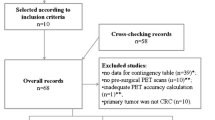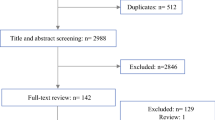Abstract
The largest randomized controlled trial (RCT) on the effect of FDG-PET on surgical management for metastatic colorectal adenocarcinoma to liver (“PET-CAM”) reported only a modest change in surgical management (8%).
Purpose
To explore the relationship between prior chemotherapy and detection of metastatic disease on PET in patients from PET-CAM. Secondary aim: to determine whether centralized imaging interpretation could have impacted trial results.
Methods
The study included 120 patients from a single institution. Local PET interpretation (PET-L) was recorded from the original database. Retrospective PET interpretation was performed independently by at least one additional reader (PET-C). The presence of extrahepatic disease (EHD) and significant additional liver metastases (=SALM), defined as metastases not originally planned for resection, was recorded. Patients were stratified to responders to recent chemotherapy (Group R) versus all others (Group O) according to surgical pathology and RECIST criteria.
Results
Thirty-seven of 50 patients who received recent chemotherapy (<90 days) were responders (Group R). EHD was present in 30/120 (25%) patients. There was no difference in detection of EHD on PET-L (7/37;18.9%), PET-C (7/37;18.9%), and CT (4/37;10.8%) for Group R (p = 0.375), but in Group O more EHD was detected on both PET-L (15/83;18.1%) and PET-C (22/83;26.5%) than CT (8/83;9.6%); p = 0.039 and p < 0.001, respectively. For the entire cohort, PET-L and PET-C detected EHD and/or SALM not reported on CT in 14 (11.7%) and 22 (18.3%) patients.
Conclusion
The impact of recent chemotherapy on detection of colorectal metastases with PET suggests that the utility of PET in patient selection for liver resection in the prior PET-CAM-RCT may have been underestimated.




Similar content being viewed by others
References
Moulton CA, Gu CS, Law CH, Tandan VR, Hart R, Quan D, et al. Effect of PET before liver resection on surgical management for colorectal adenocarcinoma metastases: a randomized clinical trial. JAMA. 2014;311(18):1863–9.
Sorensen M, Mortensen fV, Høyer M, Vilstrup H, Keiding S. FDG-PET improves management of patients with colorectal liver metastases allocated for local treatment: a consecutive prospective study. Scan J Surg 2007;96(3):209–213.
Arulampalam TH, Francis DL, Visvikis D, Taylor I, Ell PJ. FDG-PET for the pre-operative evaluation of colorectal liver metastases. Eur J Surg Oncol. 2004;30(3):286–91.
Kantorová I, Lipská L, Bêlohlávek O, Visokai V, Trubac M, Schneiderova M. Routine (18)F-FDG PET preoperative staging of colorectal cancer. J Nucl Med. 2003;44(11):1784–8.
Wiering B, Krabbe PF, Jager GJ, Oyen WJ, Ruers TJ. The impact of fluor-18-deoxyglucose-positron emission tomography in the management of colorectal liver metastases. Cancer. 2005;104(12):2658–70.
Desai DC, Zervos EE, Arnold MW, Burak WE Jr, Mantil J, Martin EW Jr. Positron emission tomography affects surgical management in recurrent colorectal cancer patients. Ann Surg Oncol. 2003;10(1):59–64.
Ruers TJ, Wiering B, van der Sijp JR, Roumen RM, de Jong KP, Comans EF, et al. Improved selection of patients for hepatic surgery of colorectal liver metastases with 18F-FDG PET: a randomized study. J Nucl Med. 2009;50:1036–41.
Akhurst T, Kates TJ, Mazudar M, Yeung H, Riedel ER, Burt BM, et al. Recent chemotherapy reduces the sensitivity of [18F]fluorodeoxyglucose positron emission tomography in the detection of colorectal metastases. J Clin Oncol 2005;1;23(34):8713–9716.
Glazer ES, Beaty K, Abdalla EK, Vauthey JN, Curley SA. Effectiveness of postiron emission tomography for predicting chemotherapy response in colorectal cancer liver metastases. Arch Surg. 2010;145(4):340–5.
Lubezky N, Metser U, Geva R, Nakache R, Shmueli E, Klausner JM, et al. The Role and Limitations of 18-Fluoro-2-deoxy-d-glucose Positron Emission Tomography (FDG-PET) Scan and Computerized Tomography (CT) in Restaging Patients with Hepatic Colorectal Metastases Following Neoadjuvant Chemotherapy: comparison with Operative and Pathological Findings. J Gastrointest Surg. 2007;11(4):472–8.
Gruenberger B, Scheithauer W, Punzengruber R, Zielinski C, Tamandl D, Gruenberger T. Importance of response to neoadjuvant chemotherapy in potentially curable colorectal cancer liver metastases. BMC Cancer. 2008;8:120.
http://www.fda.gov/downloads/drugs/guidancecomplianceregulatoryinformation/guidances/ucm268555.pdf. Accessed Nov 2015.
https://www2.rsna.org/re/twotopicimagingworkshoppresentations/Index%20Files/Sullivan.pdf. Accessed Nov 2015.
Eisenhauer EA, Therasse P, Bogaerts J, Schwartz LH, Sargent D, Ford R, et al. New response evaluation criteria in solid tumours: revised RECIST guideline (versions 1.1). Eur J Cancer. 2009;45(2):228–47.
House MG, Ito H, Gönen M, Fong Y, Allen PJ, DeMatteo RP, et al. Survival after hepatic resection for metastatic colorectal cancer: trends in outcomes for 1,600 patients during two decades at a single institution. J Am Coll Surg. 2010;210(744–52):752–5.
Weiss MJ, D’Angelica MI. Patient selection for hepatic resection for metastatic colorectal cancer. J Gastrointest Oncol. 2012;3:3–10.
Altendorf-Hofmann A, Scheele J. A critical review of the major indicators of prognosis after resection of hepatic metastases from colorectal carcinoma. Surg Oncol Clin N Am. 2003;12:165–92.
Nordlinger B, Sorbye H, Glimelius B, Poston GJ, Schlag PM, Rougier P, et al. Perioperative chemotherapy with FOLFOX4 and surgery versus surgery alone for resectable liver metastases from colorectal cancer (EORTC Intergroup trial 40983): a randomised controlled trial. Lancet. 2008;371:1007–16.
Jaeck D. The significance of hepatic pedicle lymph nodes metastases in surgical management of colorectal livermetastases and of other liver malignancies. AnnSurg Oncol. 2003;10(9):1007–11.
Author information
Authors and Affiliations
Corresponding author
Rights and permissions
About this article
Cite this article
Metser, U., Halankar, J., Langer, D. et al. Effect of chemotherapy on the impact of FDG-PET/CT in selection of patients for surgical resection of colorectal liver metastases: single center analysis of PET-CAM randomized trial. Ann Nucl Med 31, 153–162 (2017). https://doi.org/10.1007/s12149-016-1139-y
Received:
Accepted:
Published:
Issue Date:
DOI: https://doi.org/10.1007/s12149-016-1139-y




